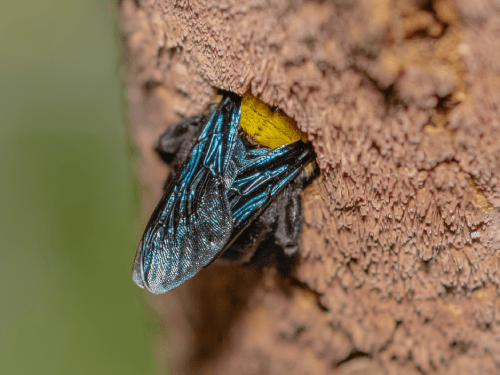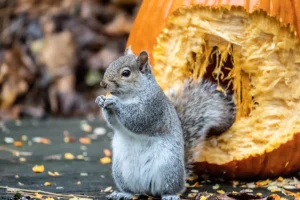Home / Blog / How To Get Rid of Carpenter Bees
How To Get Rid of Carpenter Bees

Scientifically reviewed by Daniel Baldwin, BCE, CCFS, CP-FS
-Published on September 26, 2022
-Updated on July 13, 2023
Carpenter bees can cause a lot of destruction to the wood structures of homes by weakening the wood over time. These bees drill holes into wooden floors, walls, and ceilings to create their shelters. Learn more about carpenter bees, what they look like, if they’re pollinators and beneficial to the environment, and how to keep them away from your home.
What are carpenter bees?
A carpenter bee looks a lot like a bumblebee, but carpenter bees are quite different from their other bee relatives. For instance, the carpenter bee is a solitary insect that makes nests in wood cavities, while bumblebees are social and live in colonies.
The genus name for carpenter bees is Xylocopa, which means “wood-cutter.” Carpenter bees can damage the wood in your home, while bumblebees don’t nest this way.
Here are some other characteristics of carpenter bees:
- They have a smooth, shiny abdomen with yellow markings and black circles on the thorax
- The males have some yellow or white markings on their face, depending on the species
- Measures between ¾–1″ in length
- These insects have large and powerful mandibles to chew and bore holes into wood
Carpenter bees can become very bold and protective of their territories if they feel it’s being threatened. The male carpenter bees, who cannot sting, are the most aggressive in defending their mating territory. They’ll fly close to and hover over humans in a threatening way. The female will defend herself with a painful sting, although she will only do so if she is physically threatened or touched.
How long do carpenter bees live?
Carpenter bees that live alone tend to survive for about one year. Some live with subordinate queens, which increases their lifespan by a couple more years. Each solitary queen constructs her own nest out of wood. These sturdy nests protect the queen’s eggs and allow her or another queen to reuse the nest. If a queen reuses a nest, she will expand it and lay more eggs due to the increased room.
During the winter months, the bees hibernate inside their wood nests, while during the spring, they mate and construct new nests, if needed.
What do carpenter bees eat?
Since carpenter bees are known for excavating wood, many people think wood is their primary food source.
The truth is that their diet consists mainly of nectar and plant pollen. The nectar from flowering plants gives them energy and nutrients, and pollen, derived mostly from clover and roses, provides them with protein.
This means that carpenter bees are beneficial pollinators of flowering plants and agricultural crops across the U.S. However, these insects are also considered to be unwelcome pests due to their potential to cause extensive damage to wooden structures.
How much damage can carpenter bees cause?
A carpenter bee can chew through about an inch of tunnel each day.
Adult carpenter bees like to make their homes in all types of wood, although they prefer wood that’s unpainted, unstained, and not pressure treated. These softwoods seem to be their favorites:
- Redwood
- Cedar
- Cypress
- Pine
You might find that these bees usually like nesting in porch ceilings, window and door framing, rafters, and wood siding.
As woodcutters, female carpenter bees use their mandibles to chew precise, round holes in wood to create long-lasting nests they can use over and over again throughout the years. The females excavate tunnels to make homes for their offspring and even erect walls within the tunnels from the wood shavings. The larger the nest, the more offspring a queen can produce over her lifetime.
Because carpenter bees make such large nests, the tunnels can become several feet long over time, causing structural damage in the wood of your home by weakening its overall support structure. The larva of carpenter bees can also attract woodpeckers to these wooden nests. These birds will further damage the wood as they peck away while hunting for the larva. Seeing and hearing a woodpecker on your home’s eaves may be a sign of a carpenter bee infestation.
How to protect wood from carpenter bees
More clear signs that you have carpenter bees in your home include holes that are roughly the diameter of a human’s finger in any visible wood. You’ll notice some sawdust under an entry hole when the bee first begins tunneling, as well. Although carpenter bees prefer certain types of wood, they are capable of drilling through any wood structures on your property to build their nesting tunnels.
You can protect your wood from destructive carpenter bees by:
- Spraying wood surfaces with residential insecticides made for this purpose
- Using insecticidal dust close to or inside holes where the bees are already nesting
- Installing a bee trap or “hotel” that will pull the carpenter bees away from the wood (then you can release the insects elsewhere)
- Playing loud music with speakers close to the holes since they’re sensitive to the vibrations
- Painting or staining bare wood surfaces
- Fixing holes that already exist by filling them in and painting or staining the wood
- Keeping up with repairs of wooden structures, such as filling in holes and painting
How to get rid of carpenter bees
If the above DIY tips to protect your wood aren’t working, it’s a good idea to call in a professional pest company, especially when dealing with any kind of bees. An inspection to locate where carpenter bees are boring and subsequent treatment of the bored holes will often be followed by a sealant to plug each hole to ensure the bees do not return.
Professional pest services can address a carpenter bee infestation, helping you not only protect your home from wood-related damage, but also advising you on how to address an infestation of these pollinators.
Related Articles
Visit our blog to learn more.
→






